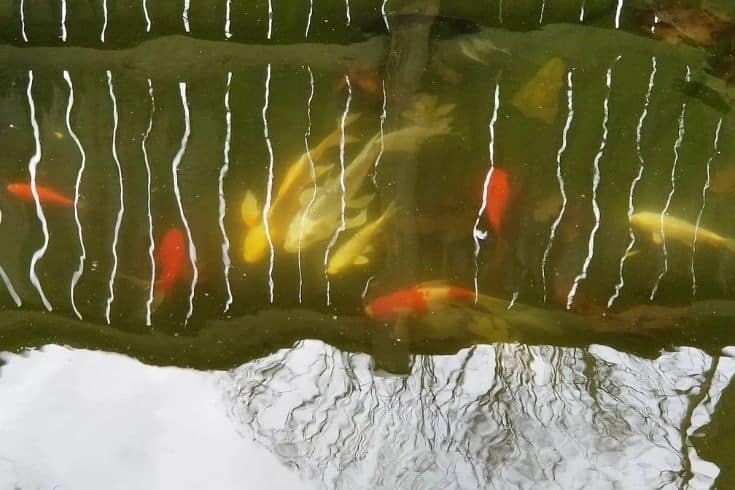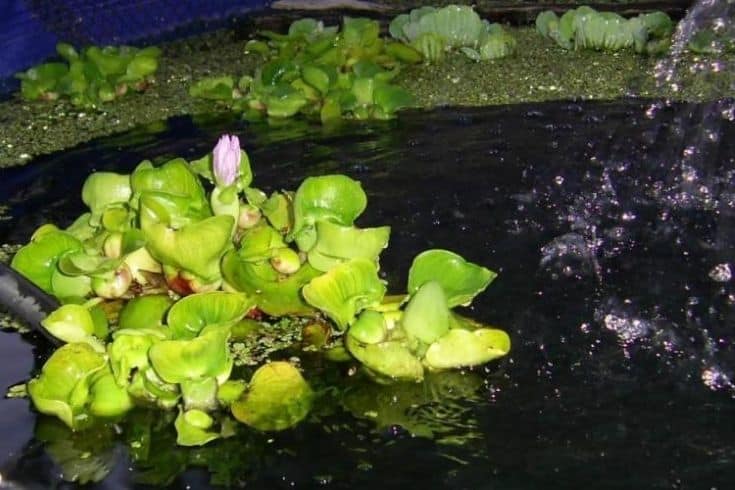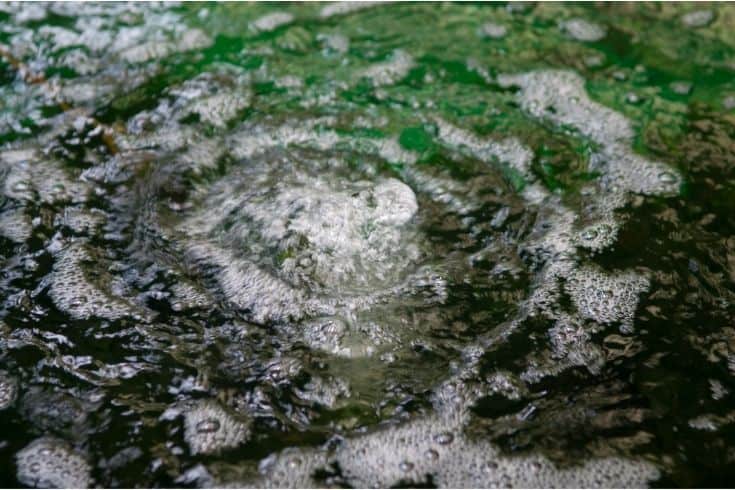Koi and goldfish share many things in common. Both fish species are members of the carp family and can reach impressive sizes. They both have beautiful colors and patterns that make them a joy to look at, and they both are popular choices among fish keepers around the globe. But can koi and goldfish live together?
The answer is yes, sort of. Koi and goldfish can coexist in the same pond, but there are a few things you need to know first. This article will go over everything you need to know about keeping koi and goldfish together.
Can Koi and Goldfish Live Together?
Goldfish and koi can live together in a tank when they’re not fully grown, but it’s not something you should do permanently. While goldfish only grow up to 10 inches long, kois are larger fish that exceed 3 feet in length, and most goldfish tanks won’t be suitable for them!
Keeping Adult Goldfish and Koi Together

As previously mentioned, it is possible to keep goldfish and koi together while the latter is still juvenile. Under most circumstances, this works well. The issue arises when the koi reaches adulthood and outgrows its tank. At this point, the most practical solution is to find a new home for your koi. However, keeping adult goldfish and koi together remains possible, as long as you take some essential precautions.
Here are a few things to keep in mind if you’d like to keep your koi and goldfish together:
Make Sure You Have Enough Space
As we mentioned, koi can reach lengths of 3 feet or more, which rules out the possibility of housing your koi and goldfish in a fish tank. However, outdoor ponds can easily accommodate koi and goldfish, as long as you have enough space. A good rule of thumb is to allocate 240 gallons of water per adult koi and 24 gallons per adult goldfish. Therefore, your pond’s minimum size will increase with every additional fish you introduce to it.
Where depth is concerned, you’ll need to aim for at least 3 feet deep, allowing the koi plenty of space to swim around and explore. Though they aren’t pond fish, goldfish will also benefit from the extra depth, giving them a place to hide if they feel stressed. Your goldfish will be just as happy outdoors as in a conventional tank in a properly maintained pond.
Because of the large amount of space that koi require, keeping a goldfish and koi together isn’t ideal unless you have an outdoor pond. If you’re looking for indoor options, consider using separate tanks instead of trying to squeeze both species into the same tank or pond.
Filter Your Pond Carefully
Koi and goldfish produce a lot of waste, so it’s vital to have a sound filtration system to keep the water clean. We recommend using a pond filter that’s designed specifically for koi ponds. This type of filter will typically have larger chambers for holding debris, and it will be able to handle the large amounts of waste produced by koi and goldfish.
You’ll also want to use a UV sterilizer in your pond, which helps keep algae levels under control. In addition, installing an aeration pump will help keep the water oxygenated. Well-oxygenated water is critical if you have fish that prefer to stay at the bottom of the pond, and freshwater is a general need for all fish species.
Given the large amount of waste produced by both fish species, you’ll need to do regular water changes to keep ammonia levels at bay. We recommend doing a 25% water change every two weeks to maintain high water quality. These are hardy fish, but they’ll still require clean water to thrive! If you’re ever in doubt, do a quick water test to ensure that all water parameters are in check.
Temperature Control Is Key

Koi are cold-water fish and can tolerate cooler waters ranging from 34 degrees to 90 degrees Fahrenheit. In contrast, goldfish prefer warm water with a temperature range between 65 to 75 degrees Fahrenheit. What this means for someone intending to house koi and goldfish together is that although kois can tolerate cool aquarium water, you’ll need to keep the water temperature on the warmer side to accommodate the goldfish.
Install a pond heater and set the temperature somewhere between 70 and 75 degrees Fahrenheit. This will keep your goldfish happy while still allowing the koi to thrive. As a bonus, you’ll be able to enjoy your outdoor pond even during the cold winter months when all the other ponds are covered in ice.
One thing to keep in mind is that keeping a large pond heated is a costly affair for many people. You have to worry about the initial investment of a pond heater, and you’ll also need to factor in the cost of running it. If this is the case, you might want to consider keeping your goldfish in a separate tank indoors, where it’s easier to control the water temperature.
Introduce Live Plants
If you thought live plants were just for fish bowls, think again! Adding plants to your pond is a great way to help keep the water clean and provide both koi and goldfish with some shelter. We recommend using hardy plants that can tolerate being close to fish. Good options include the water hyacinth, irises, cattails, and rushes.

Plants help keep the water clean by absorbing excess nutrients, but they also do a great job replicating koi and goldfish’s natural habitats. These fish would typically spend their time swimming among plants in the wild, so adding plants to your pond will help create a more natural environment for them.
Suffice to say; all this will also elevate the aesthetic appeal of your pond. Picture this – fish in a variety of colors swimming among gorgeous plants. It’s sure to be a showstopper!
Provide A Good Quality Diet
Keep your fish healthy by feeding them high-quality fish food. We recommend looking for a food specifically designed for koi or goldfish, as these formulas contain all the nutrients these fish need to stay healthy. The difference between koi fish food and goldfish food is that koi food typically contains more protein, while goldfish food has a higher carbohydrate content.
In addition, you’ll want to make sure that the types of food you choose don’t contain any harmful ingredients that could potentially harm your fish. Some things to watch out for include fillers, artificial flavors, and colors. Most high-grade fish food brands will clearly state on the label if their products are safe for koi and goldfish, so be sure to check before making a purchase.
On top of flake fish food, many fishkeepers also find themselves gravitating toward natural food sources. Koi and goldfish love eating live foods such as worms, brine shrimp, and daphnia. Not only is this a fun way to feed your fish, but it’s also a great way to add some variety to their diet. A good diet keeps your fish healthy for both overall well-being and appearance.
Take Species-Related Differences Into Account
Species-related differences do not just end at the distinction between kois and goldfish. The varieties specific to each species of fish can also play a significant role in their compatibility. For example, although goldfish aren’t tropical species, they prefer warmer temperatures. However, comet goldfish have a unique preference for slightly cooler temperatures. On the other hand, fancy goldfish like the Ryukin Goldfish prefer even warmer water than most other goldfish varieties.
There are differences in fish personalities that you should be aware of. Some varieties of koi grow larger than others, and some koi may even become aggressive at feeding time if their food source is scarce or they are feeling hungry. Left unchecked, this can lead to fish bullying or even death. To avoid this, you’ll need to make sure that you take these personality differences into account when choosing which fish to house together in your pond.
Other important things to consider are the pond size, water quality, diet, and general maintenance. By taking all these factors into account, you’ll be able to maximize the odds of compatibility between koi and goldfish, keeping both species happy and healthy!
Pay Special Attention To Fish Fry
If you’re a fish owner intending to breed your koi or goldfish, you’ll need to pay special attention to the fish spawn. Baby fish are extremely vulnerable, and other fish can easily injure them in their community. If your koi fish pond is home to both adult koi and goldfish, make sure that you separate the fry as soon as possible. Even if you have friendly fish, it’s always better to be safe than sorry.
You can either move the fry to a separate tank or put up a temporary barrier in your pond using netting. Just make sure that the netting has small enough holes so that the fry can’t slip through. Once the fry has grown large enough, you can remove the netting to let them swim freely again. However, it’s good to keep an eye on any larger fish that may still pose a threat.
Those wishing to err on the side of caution can also separate pregnant female koi fish from the rest of the community. This will give them a chance to lay their eggs in peace, and you can then move the fry to a separate tank once they’ve hatched.
Make Sure To Oxygenate Your Pond

One of the most important things to keep in mind when housing koi and goldfish together is the importance of oxygenating your pond. Both of these species are extremely sensitive to changes in water quality. They require a high level of dissolved oxygen, ample water flow, and excellent water quality to stay healthy.
You can usually achieve this in aquarium environments by purchasing an air pump. However, you’ll need to find another way to add oxygen to your water in ponds. Some suitable methods include setting up a waterfall or putting a fountain in the pond. Whatever method you choose, make sure to keep it running at all times if you want optimal results!
The presence of algae can also interfere with your pond’s oxygen levels. It will effectively take up some oxygen and leave less for your fish to breathe as it grows in your water. To avoid this problem, you’ll need to ensure that you’re doing everything to maintain good water quality. This includes getting proper filtration and using a pond skimmer regularly.
The Takeaway
By keeping these factors in mind, you’ll be well on your way to successfully housing koi and goldfish. Remember – the most practical way to do this is by keeping smaller koi and goldfish together, rather than large varieties of both. Stay vigilant about water quality, feed your fish a nutritious diet, and use proper filtration and oxygenation techniques to keep things running smoothly!
Do you have any tips for ensuring that koi and goldfish can live together? Share your advice in the comments below! Don’t forget to check our article on the best place to buy koi fish. We also have one for goldfish. Thanks for reading, and till we meet again!
